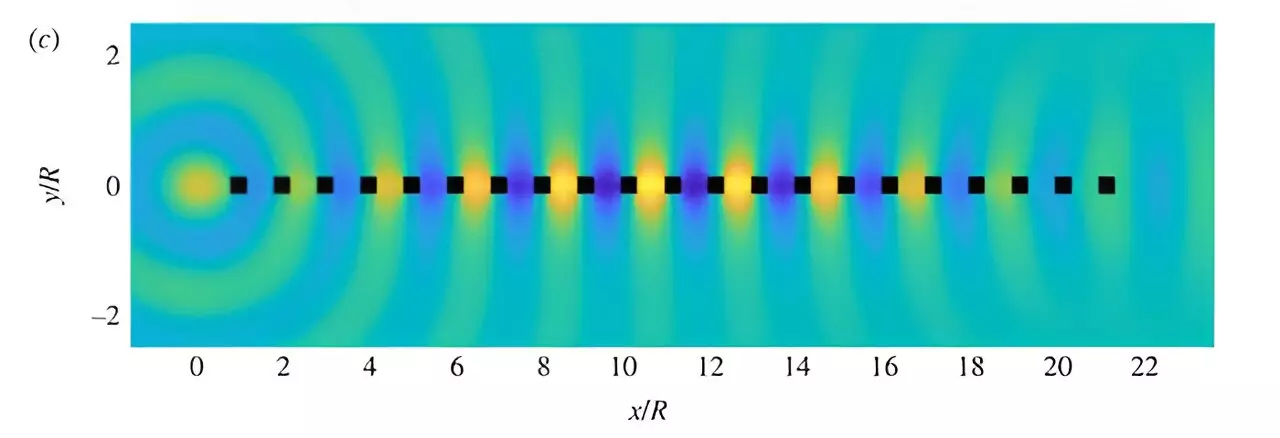Recent advancements in computational science have ushered in a new era for materials engineering, particularly concerning metamaterials—innovative substances designed to manipulate waves across various spectra, including sound, light, and electromagnetic radiation. A remarkable development in this field comes from researchers at Macquarie University who have introduced TMATSOLVER, a state-of-the-art software that models wave-particle interactions with unprecedented precision. This article explores the implications and capabilities of TMATSOLVER and how it paves the way for future metamaterial designs.
TMATSOLVER employs a multipole method to calculate how waves scatter upon encountering a range of particles with complex geometries and varying physical properties. Previously, simplifications were necessary to study wave interactions, often limiting the practical applications of metamaterials. Lead researcher Dr. Stuart Hawkins emphasizes that the software enables simulations of intricate configurations that were unmanageable before. By effectively utilizing the transition matrix (T-matrix)—a mathematical representation that encapsulates scattering behavior—the software offers a detailed approach to analyzing particle interactions across multiple wavelengths.
This progress is particularly important in the realm of metamaterials, which require precise control over the interplay of wave characteristics influenced by nanoscale design elements. Dr. Hawkins’ statement about advancing T-matrix capabilities marks a significant leap, especially in modeling larger particles that exceed wavelength dimensions. This aspect reflects the sophisticated nature of modern metamaterials and the requirements of accurate simulation tools for their design.
Collaborative Academic Efforts
The success of TMATSOLVER is not merely the work of a single institution; it is the product of international collaboration among several reputable institutions, including the University of Adelaide and Imperial College London. By pooling expertise and resources, the researchers have streamlined the process of calculating complex metamaterials, removing previous computational bottlenecks that hindered scientific exploration.
Co-author Dr. Luke Bennetts from the University of Adelaide underscores this collaborative nature, noting that TMATSOLVER significantly facilitated the generalization of metamaterial tests. It not only improved computational efficiency but also broadened the scope of potential metamaterial applications. This collaboration showcases how interdisciplinary approaches can yield innovative solutions, fostering advancements that transcend geographical and institutional boundaries.
The implications of TMATSOLVER extend far beyond theoretical research. Metamaterials hold the key to groundbreaking applications in fields as diverse as telecommunications, imaging, and energy management. For instance, manipulating electromagnetic waves allows for the invention of devices such as super-lenses capable of providing surreal levels of detail at the molecular level. Additionally, concepts like invisibility cloaks are no longer confined to the realm of science fiction, representing tangible possibilities in current research.
Another fascinating application is the development of systems engineered to absorb or redirect sound and energy, which holds promise for advancing green technologies and enhancing architectural acoustics. By facilitating rapid prototyping and validation of these designs, TMATSOLVER could expedite the transition from theory to application, benefiting sectors of science and industry alike.
Concluding Thoughts
The introduction of TMATSOLVER represents an important advancement in the field of metamaterials, a domain poised to revolutionize how we interact with waves across different mediums. With capabilities that allow researchers to simulate complex scatterer arrangements efficiently, the software promises to enhance experimental designs and accelerate innovation in materials science. As expressed by Professor Lucy Marshall, the potential breakthroughs made possible by this tool can catalyze significant progress across various disciplines, demonstrating the indispensable role of advanced computational methods in driving the future of materials engineering.
This transformative technology not only amplifies our understanding of wave interactions but also sets the stage for actualizing previously theoretical advancements into practical tools that could redefine conventional boundaries of science and technology. As research further unfolds, the metamaterial landscape will undoubtedly continue to evolve, influenced by the capabilities brought forth by TMATSOLVER and similar innovations.


Leave a Reply